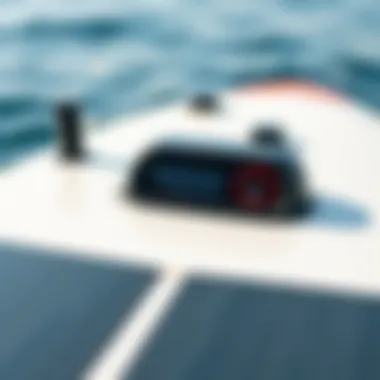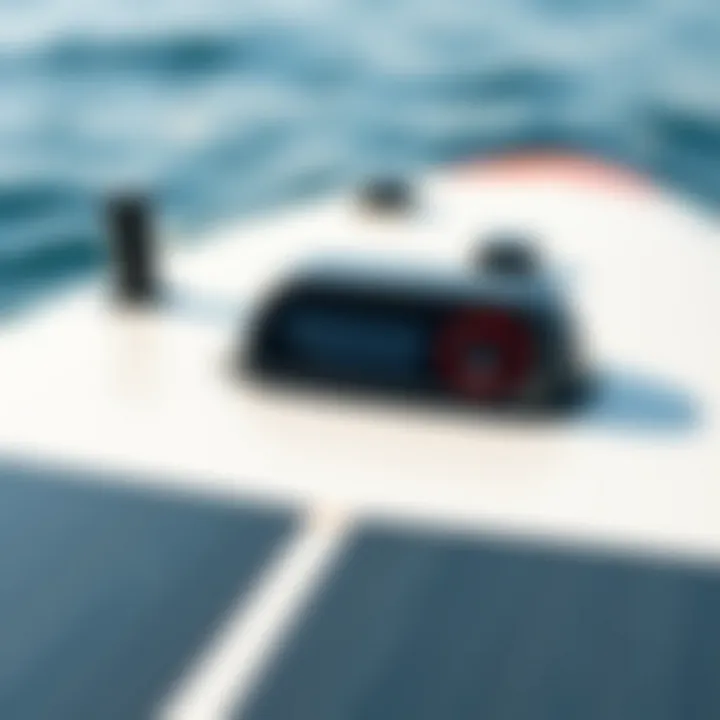Exploring Price Factors of Motorized Surfboards


Intro
The surge in popularity of motorized surfboards in recent years marks a new chapter in the watersports industry. These innovative devices combine the thrill of traditional surfing with the convenience of powered propulsion, offering an exhilarating experience for both beginners and seasoned athletes alike. However, navigating the market can be a daunting task. There’s more to the price of a motorized surfboard than meets the eye. The disparity in costs can leave potential buyers scratching their heads about what they’re actually paying for. Hence, it’s crucial to unpack the various factors influencing the pricing dynamics of these boards.
As we delve into this guide, we’ll highlight the key points regarding brand variations, market trends, and consumer preferences that not only shape the prices but also impact user experience. The goal is not only to equip readers with actionable insights but also to provide a deeper understanding of how these factors reconfigure the watersports landscape. By comprehensively exploring the price structures and their implications, this analysis will benefit a broad audience—from athletes and coaches looking to invest in quality gear to travel agents seeking informed recommendations.
Tips and Techniques
When it comes to enjoying the exciting yet intricate world of motorized surfing, having a grasp on both fundamental and advanced techniques can significantly enhance your experience.
Beginner Tips for Watersports
Starting off, it’s advisable to familiarize yourself with the basic principles of balance, steering, and throttle control. Here are a few tips to get you started:
- Wear Appropriate Gear: A life jacket is a must for safety. It keeps you afloat in case of a fall, and generally gives you peace of mind.
- Understand the Equipment: Before you hit the water, take some time to understand the features of your surfboard, such as the throttle responsiveness, battery life, and weight capacity. Different brands come with their own quirks.
- Choose a Suitable Location: Look for calm waters to practice. Crowded beaches can be as distracting as they are dangerous, especially for newcomers.
Engaging in practice runs with an experienced buddy can also provide reassurance as well as immediate feedback.
"The right board doesn’t just power your ride; it amplifies your connection to the water."
Advanced Techniques for Mastery
For those already familiar with the basics, take your skills up a notch with these advanced techniques:
- Learn to Carve: Once confident, try carving turns aggressively. Engaging the body weight properly will let you experience more control and maneuverability.
- Use Waves to Your Advantage: Combining your board's propulsion with the natural waves can create a thrilling ride. Timing is crucial here.
- Experiment with Speed Control: Mastering the throttle allows for intricate movements and fluid transitions that can dramatically improve your performance.
Practicing these techniques can significantly boost not only your skills but also your overall joy in mastering motorized surfing.
Preamble to Motorized Surfboards
Motorized surfboards have carved out a niche in the watersports market that is growing at an astonishing pace. This surge in interest underscores a substantial shift in how enthusiasts interact with the ocean. Understanding this phenomenon is essential for anyone looking to dive into the exhilarating world of motorized surfing. The continual evolution of these devices encapsulates not only technological advancements but also changing mindsets regarding recreation and competition.
The concept of a motorized surfboard marries the adrenaline rush of surfing with the ease of powered propulsion. This opens up new avenues for riders of varying experience levels. It goes beyond mere fun; motorized surfboards have the potential to greatly assist in training scenarios, enabling novice surfers to gain confidence without the immediate challenges of traditional surfing. The benefits extend to far-off surfing locations, where accessibility becomes a game changer.
A key element in this discussion is the growing community around motorized surfboards. Various forums and social media platforms, such as Reddit or Facebook, are filled with enthusiasts sharing tips, experiences, and recommendations. It fosters a sense of belonging while providing a trove of information for potential buyers and users.
Ultimately, a clear grasp of motorized surfboards can offer significant advantages. From selecting the right model to comprehending the pricing dynamics that vary widely across different brands and specifications, being informed equips consumers to make enlightened choices. As we journey through the various aspects of motorized surfboards, we will unearth insights that not only clarify the pricing but also reflect the broader landscape of the sports industry.
What are Motorized Surfboards?
Motorized surfboards, by definition, are surfboards equipped with electric motors that provide propulsion. They allow riders to glide over water without relying on the energy of waves. Typically, these devices come with a battery, an electric motor, and sometimes a remote control that enables the user to adjust speed and direction. Sometimes they are also designed to resemble traditional surfboards, providing a familiar aesthetic while still incorporating cutting-edge technology.
In terms of operation, a motorized surfboard can be straightforward to use, which is particularly appealing to beginners. With the flick of a switch, users can transition from a stationary position to zipping along the surf. However, it's worth noting that safety precautions are paramount. Riders need to be aware of their surroundings, especially in crowded waters.
The Rising Popularity of Motorized Surfboards
Over the last few years, motorized surfboards have seen a meteoric rise in popularity. Factors like the increase in adventure tourism and a shift toward sustainable recreation have driven this trend. Individuals from various backgrounds are now embracing motorized surfing, from professional athletes looking to enhance their skill set to casual beachgoers seeking a new thrill.
One reason behind this surge is the thrill of blending traditional surfing with a fresh, modern twist. Many people want to experience the ocean in new and exciting ways, and motorized surfboards fit right into that narrative. Moreover, social media has played a substantial role in propelling visibility. Viral videos showcasing riders soaring across the waves have ignited curiosity and interest among potential new users.
In addition, as more brands enter the marketplace, competition is increasing, making these surfboards more accessible in terms of pricing and availability. Easy-to-use options mean that enthusiasts do not need extensive training or experience to enjoy the ride. The combination of ease of access, diversity in design, and the allure of exploration works hand in hand to create a compelling case for these innovative devices.
Factors Influencing Motorized Surfboard Prices


Brand Recognition and Reputation
In the realm of motorized surfboards, brand recognition holds significant weight. A well-established brand often commands a higher price, reflecting consumer trust built over years. For instance, manufacturers like AquaBuddy or WaveRider have spent time cultivating a reputation for quality and performance. Many buyers lean toward these names, believing that the higher costs correlate with superior reliability.
However, it’s not solely about the name; it's also about the associated warranty and customer support, which are typically more robust with prominent brands. This added sense of security can justify spending a bit extra, as there’s less concern about service after the sale. Ultimately, the brand image intricately ties into price; a household name in the sport may often be seen as the gold standard.
Material Quality and Construction
Another considerable factor is the material quality used in fabrication. Motorized surfboards are often constructed from a variety of materials, each with distinct benefits and costs. For example, boards made from high-grade carbon fiber are lighter and more durable compared to those crafted from basic fiberglass. This difference results in a noticeable price gap. While a more expensive board may seem steep initially, it typically offers greater resilience against wear and tear, ultimately extending its lifespan.
Additionally, the craftsmanship involved in construction impacts pricing. Boards that are hand-finished or come from boutique manufacturers might attract a premium due to their enhanced attention to detail and artistry. Given that durability significantly affects the user's experience on the water, the investment in quality materials can pay dividends over time.
Motor Size and Power Output
When discussing motorized surfboards, the motor’s performance features prominently in pricing. Typically, more powerful motors, capable of achieving higher speeds and providing better control, demand a higher price. For instance, models equipped with robust 3000-watt motors can cost significantly more than those with basic setups, particularly if they enhance user experience by allowing for smoother rides in choppier conditions.
Moreover, buyers must consider torque availability and the overall efficiency of the motor. Efficient motors not only improve performance but also tend to consume battery life better, giving an additional edge in value. Higher-powered, reliable engines can substantially boost the surfboard's overall enjoyment and performance level, making them a worthwhile investment.
Battery Life and Technology
In a tech-driven world, the battery technology of motorized surfboards cannot be overlooked. The type of battery, its capacity, and the technology behind it directly influence both price and usability. For example, lithium-ion batteries, though pricier, offer better longevity and faster charging capabilities compared to standard lead-acid batteries. Knowledgeable consumers understand that spending a little extra on superior battery technology can ultimately go a long way in ensuring that they get more time on the water before needing to recharge.
Moreover, advancements in battery technology also contribute to weight reduction, with lighter batteries making surfboards easier to maneuver. Investing in top-tier battery technology is akin to investing in the future of the sport, as users often get greater value from boards that consistently outperform cheaper counterparts.
Design Features and Aesthetics
Finally, the design features and overall aesthetics of motorized surfboards can impact their price significantly. Here, personalization and uniqueness often come into play. Surfboards that boast eye-catching designs or customizable options tend to attract consumers looking for style alongside performance. Even if a board performs the same as a less stylish counterpart, the aesthetic appeal can sway consumer decisions.
Beyond looks, ergonomic designs that enhance comfort or usability can also lead to higher price points. For instance, surfboards designed with grips or specialized fins tend to offer improved handling and performance, which reinforces the notion that paying a bit more can result in a much more enjoyable experience overall.
Price Ranges of Motorized Surfboards
Understanding the price ranges of motorized surfboards is vital for anyone looking to make a purchase. These watercraft are not merely toys; they represent significant investments that can enhance one’s experience on the water. The price can vary drastically due to several elements such as brand credibility, build quality, and sophisticated features that elevate one model over another.
These distinctions in pricing are not just academic discussions or theoretical boundaries; they have real implications for potential buyers. Every dollar spent influences the materials used, the craftsmanship involved, and ultimately, the performance that users can expect. Let’s dive deeper into the various price categories to equip you with insights that can guide your purchasing choices.
Entry-Level Motorized Surfboards
Entry-level motorized surfboards serve as a great introduction to the sport without breaking the bank. Priced typically between $2,000 to $4,000, these boards are designed for casual users new to the world of motorized surfing. They generally come with smaller motors and limited features, making them more suitable for leisurely rides rather than high-speed thrill-seeking.
While they may lack the bells and whistles of their expensive counterparts, they offer reliable performance and a solid experience for beginners. Many of these boards utilize basic materials, yet they are still durable enough to withstand some harsh conditions on the water. Moreover, an entry-level surfboard can provide an excellent platform for practice and skill development.
Considerations before buying an entry-level motorized surfboard might include:
- Battery life: Ensure it packs enough charge for long outings.
- Weight capacity: Some may struggle under heavier riders.
- Motor power: A lower wattage may be less thrilling but great for learning.
Mid-Range Options
For more experienced riders, mid-range motorized surfboards typically fall between $4,000 and $8,000. These boards blend performance with advanced features that appeal to those wanting to intensify their water adventures. These models often sport larger motors and improved battery technologies, facilitating longer rides and better speeds.
The construction quality goes up a notch, frequently utilizing lightweight materials such as carbon fiber to enhance performance and durability. Riders looking to experience a balance of cost and capability will find mid-range boards give them the flexibility to surf in different conditions without too much financial strain.
Important points to understand about mid-range options include:
- Features: Many come with adjustable speed settings for various skill levels.
- Customization: Some brands allow for personal modifications, enhancing user experience.
- Brand loyalty: Often, mid-range options come from brands with established reputations, meaning better customer support and reliability.


High-End Models
High-end motorized surfboards are the crème de la crème, typically priced from $8,000 upwards to $15,000 or even more. Designed for enthusiasts and professionals, these boards often feature cutting-edge technologies that maximize performance, including advanced propulsion systems and innovative battery solutions. They often include exquisite materials and craftsmanship, offering not just function but also a visual appeal that turns heads on the water.
Riders are likely to enjoy superior handling, greater speed capabilities, and extended battery life which ensures longer, uninterrupted rides. These boards may also come equipped with smart technology, allowing users to track their performance metrics or even connect to smartphones for personalized adjustments.
Factors to consider with high-end boards are:
- Performance metrics: A detailed overview of speed, handling, and durability can guide buyers.
- Resale value: While the initial cost may make you draw back, high-end boards generally have better resale values down the line.
"In the world of motorized surfboards, you tend to get what you pay for; thus, investing more can result in a ride that exceeds your wildest expectations."
Ultimately, understanding these price ranges allows prospective buyers to get aligned with their surfing ambitions while being conscious of their budget. Whether you’re aiming for joyful rides on calm waters or chasing thrills in rough conditions, be sure to assess what fits you best.
Comparative Analysis of Popular Brands
The landscape of motorized surfboards is shaped by a handful of dominant brands, each bringing their own flair and technology to the table. Analyzing these brands is essential, not just for potential buyers, but also for enthusiasts and industry professionals looking to understand market trends and consumer preferences. This comparison allows for a holistic view of what each brand offers in terms of performance, price, and unique features.
Understanding the nuances between the brands helps consumers make smarter choices, aligning their selection with personal needs, budgets, and aspirations. It also sheds light on the broader currents in the watersports industry, revealing how brand strategies can influence pricing and consumer behavior.
Leading Brands Overview
When it comes to motorized surfboards, a few names pop up frequently, each with distinct characteristics that cater to different types of riders. Some leading brands include:
- JetSurf: With a reputation for high-performance boards, JetSurf is often a favorite among thrill-seekers. Their boards blend innovation with a passion for adventure, appealing to both novices and seasoned surfers alike.
- Radinn: This brand prides itself on integrating advanced technology into their boards, offering a unique riding experience that many cannot resist. They're known for electric surfboards that boast impressive battery life and sleek designs.
- RoboSurf: Tailored for a diverse audience, RoboSurf brings affordability into the equation while still offering decent performance. This brand is carving out a niche with budget-conscious buyers who don’t want to compromise on fun.
These brands, among others, showcase a spectrum of designs, aims, and pricing strategies. Their varying approaches allow consumers to find something that meets their needs effectively.
Brand-Specific Price Comparisons
Diving deeper into the pricing, one can see a clear division based on brand reputation and features. Generally, here’s how the pricing aligns:
- JetSurf: Prices hover around $12,000 and can exceed $20,000 depending on customization and technology. This high price tag reflects the cutting-edge tech and superior build quality that serious riders seek.
- Radinn: Typically, their boards range from $8,000 to $15,000, which makes them a competitive option without skimping on performance. The technology-packed features justify their mid-range pricing.
- RoboSurf: As the more wallet-friendly choice, RoboSurf's boards can be found for as low as $3,500 up to $7,500. They're particularly appealing for those who want to dip a toe into motorized surfing without breaking the bank.
To emphasize the importance of informed purchasing:
"Researching brands and their price points is not just a cost-saving tactic; it is also an essential step towards ensuring long-term satisfaction with your purchase."
In summary, a comparative analysis of popular brands provides an invaluable framework to better understand what the market has to offer. This knowledge empowers buyers to choose motorized surfboards that match their individual requirements while navigating the diverse watersport landscape.
Market Trends and Consumer Preferences
Understanding market trends and consumer preferences is crucial for anyone looking into motorized surfboards. The watersport industry is not just about the products; it’s also about the culture and the evolving demands of consumers. Recognizing these trends can offer valuable insights that help potential buyers, industry players, and enthusiasts stay ahead of the curve.
Emerging Trends in Watersports
Watersports have traditionally comprised surfing, sailing, and jet skiing, but the advent of motorized surfboards has added a fresh spin to the mix. The trend reflects a broader shift toward innovation in outdoor recreation. Several elements stand out in this burgeoning landscape:
- Sustainability: As environmental awareness rises, manufacturers are increasingly focusing on eco-friendly materials and energy-efficient motors. The aim is to attract environmentally conscious consumers who might shy away from traditional gas-powered options.
- Technological Integration: Whether it's navigation systems or smartphone connectivity for monitoring performance metrics, the technological aspect is a significant driver. Buyers nowadays expect surfboards to not just float but also to integrate seamlessly with their connected lifestyles.
- Youth Engagement: There's a noticeable shift toward encouraging younger crowds in watersports. Brands are thus designing lightweight and easy-to-use boards that appeal to new riders and provide an engaging entry point for the adventurous youth.
- Customization Options: Another growing trend is the demand for personalized surfboards. Buyers want to express their style. Custom designs, colors, and additional features ensure that consumers feel more connected to their gear.
These emerging trends indicate that motorized surfboards are not just a fleeting novelty; they represent a meaningful evolution in the immediate and broader watersports market.
Consumer Buying Behaviors
Consumer buying behavior can significantly influence trends and sales in the motorized surfboard market. Understanding this behavior is like peeking behind the curtain to see what drives purchase decisions. Here are some key considerations:


- Research and Reviews: Before splurging on a board, consumers generally conduct thorough research. Reviews on platforms like Reddit and forums dedicated to watersports play a pivotal role in shaping opinions. Potential buyers often rely on others’ experiences to verify product efficacy and quality.
- Influence of Social Media: Instagram and YouTube have transformed the way consumers interact with products. Riders showcasing their tricks generate buzz and sometimes even inflate perceived values. Consumers tend to be more likely to follow peers or influencers when purchasing, steering them toward certain brands.
- Price Sensitivity: While new technologies and features entice many buyers, price remains a critical factor. Consumers are becoming savvier, looking for optimal value for their investments. This behavior prompts manufacturers to provide transparent pricing structures that justify the features offered.
- Demographic Influences: Age, geographic location, and lifestyle all affect what consumers look for. Younger buyers might prioritize style and performance, while older generations may focus on reliability and ease of use.
Understanding consumer behavior not only assists manufacturers in their production strategies but also enables them to tailor marketing efforts that resonate strongly with potential buyers.
In summary, the intersection of market trends and consumer preferences shapes the pricing dynamics of motorized surfboards. Every shift—toward sustainability, technology, youth engagement, and personalization—affects how enthusiasts interact with the brand and product offerings. For those intending to embrace motorized surfing, staying informed about these trends is not just helpful; it's imperative.
Long-Term Investment Considerations
When it comes to motorized surfboards, understanding the long-term investment considerations is crucial for any buyer navigating this relatively new market. Many enthusiasts can get caught up in the excitement of the latest models and flashy features. However, looking beyond immediate gratification to the overall value, long-term costs, and potential returns on investment is vital.
Resale Value Insights
Motorized surfboards, much like luxury cars, often fluctuate in do they appreciate or depreciate over time. Brands known for their durability and prestigious status tend to maintain their value better compared to lesser-known ones. For instance, considering brands that have established a solid footing in the watersports world, such as Lift Foils, may yield advantageous outcomes down the line. Potential buyers should consider a few key elements:
- Brand Reputation: The sturdiness of a board isn't just about materials; it's also about how the brand is perceived in the market. The more reputable the brand, the higher the likelihood of retaining a decent resale value.
- Condition and Maintenance: Just as a well-kept car can fetch a higher price, the condition of the surfboard matters. Regular maintenance, including battery care and hull inspection, enhances longevity.
- Technological Advancements: Technological evolution can render older models less appealing. Thus, investors should ponder how often they might upgrade, and whether a particular model could stand the test of time and technology shifts.
"In the realm of luxury items, past performance often informs future expectations. Buyers should tread wisely."
Maintenance Costs
Owning a motorized surfboard isn't a one-and-done affair; it also entails ongoing expenses. Understanding these costs can shed light on the overall investment. Initially, the price tag may seem like the main point of concern, but hidden expenses quickly add up if not properly evaluated. Here are a few areas worth considering:
- Battery Replacement: A significant portion of maintenance involves the battery, which requires eventual replacement. It's a process that cannot be avoided, and newer lithium-ion batteries can cost several hundred dollars each, impacting long-term financial calculations.
- Propulsion System & Hull Integrity: Like any watercraft, the integrity of the propulsion system and the surfboard’s hull must be monitored. Regular checks and potential repairs can prevent hefty bills later on.
- Storage Conditions: Improper storage can lead to depreciation of the board's quality and lifespan. Storing your surfboard in a controlled environment, away from excess moisture and UV rays, is advisable.
- Accessory Upgrades: Over time, one may be tempted to invest in add-ons, like upgraded fins or electronic components. While these can enhance performance, they also contribute to the total cost of ownership and must be calculated into any long-term budget.
All these considerations highlight the fact that purchasing a motorized surfboard is not just a transaction; it’s an investment decision that requires thoughtful evaluation of both upfront and ongoing costs. With this in mind, prospective buyers must keep their eyes open for current offerings while mentally preparing for future expenses.
Future of Motorized Surfboards
The future of motorized surfboards signifies an emerging frontier in watersports, capturing the imagination of enthusiasts and casual riders alike. As technology continues to evolve, the scope of motorized surfboards is expanding, bringing with it innovative advancements that promise to reshape how riders experience the water. These developments are not just technological novelties; they stand to revolutionize safety, performance, and accessibility in this fast-growing niche. Moreover, understanding the future trends in this category can provide valuable insights for potential buyers, athletes, coaches, travel agents, and educators.
Advancements in Technology
Technology in motorized surfboards is advancing at a breath-taking pace. From powerful electric engines to lightweight yet durable materials, innovations are popping up like daisies in spring. For instance, the incorporation of advanced lithium battery technology allows for longer rides without the need for constant recharging. Riders can now glide over the water for extended periods, opening up a whole new world of exploration.
Another remarkable leap is the integration of smart technology. Imagine controlling your surfboard with just a small handheld device or even your smartphone! Features like GPS tracking, speed regulation, and even ride analytics will not only enhance user experience but also make the sport more engaging for various skill levels.
"We are just scratching the surface of what these boards can do. It's like the starting point of a new era in watersports!"
— Expert Review from watersportsgear.com
Additionally, materials used in construction are evolving. Manufacturers are now utilizing carbon fiber and high-grade plastics that not only reduce weight but also increase rigidity and durability. As a result, these motorized surfboards can withstand the rigors of the ocean while offering an exhilarating ride.
Potential Market Growth
The market potential for motorized surfboards is not to be underestimated. As more people seek thrilling water experiences, the demand is expected to grow exponentially. Recent studies indicate that the global watersports equipment market size is anticipated to reach USD 3 billion by 2025, with motorized surfboards playing a significant role in this boom. More companies entering the market suggests vigorous competition, which, in turn, can lead to decreased prices and increased variety for consumers.
Furthermore, the increasing emphasis on sustainability could drive innovation in eco-friendly designs. Riders are becoming more conscious of their environmental footprint, and manufacturers are taking note by investing in greener technology.
This demand translates into various opportunities beyond just consumers. Coaches and trainers can also tap into this trend by offering specialized lessons on motorized boards, thereby diversifying their services. Tourism operators may also venture into introducing motorized surfboards as rental options in popular holiday destinations, significantly enhancing tourists’ experiences.
In summary, the future of motorized surfboards is bright, fueled by technological advancements and an expanding consumer base. By understanding these developments, stakeholders in the watersports realm can position themselves strategically to take advantage of upcoming opportunities, ultimately enriching their practices and offerings.
Finale
The examination of motorized surfboards is crucial, particularly as the sport evolves and the market matures. This section underscores the significance of understanding the pricing dynamics related to various factors involved in the buying process. It's essential for future buyers to appreciate how aspects such as technology advancements, brand reputation, and material quality contribute to the overall cost of these thrilling watercraft.
One of the key elements discussed is the varied price segmentation available within the market, from entry-level boards to high-end models. Consumers armed with this knowledge are better positioned to make purchasing decisions that not only align with their budgets but also meet their expectations in terms of performance and durability. Importantly, recognizing the potential for resale values and maintenance costs can greatly influence the long-term enjoyment of a motorized surfboard. As purchasing a surfboard is often a significant investment, comprehending these intricacies can lead to more gratifying ownership experiences.
Understanding the intricacies of pricing enables consumers to choose options that reflect both personal and financial preferences while ensuring satisfaction in the long run.
Delving into market trends, including consumer preferences, also reveals a broader context for decision-making. As motorized surfboards become more integrated into mainstream watersports culture, awareness of these trends can foster a deeper engagement with the sport, creating a community that extends beyond purchasing decisions.
Thus, this conclusion serves to encapsulate the critical points raised throughout the discussion on the price dynamics of motorized surfboards, providing valuable insights that empower consumers and enthusiasts alike.















